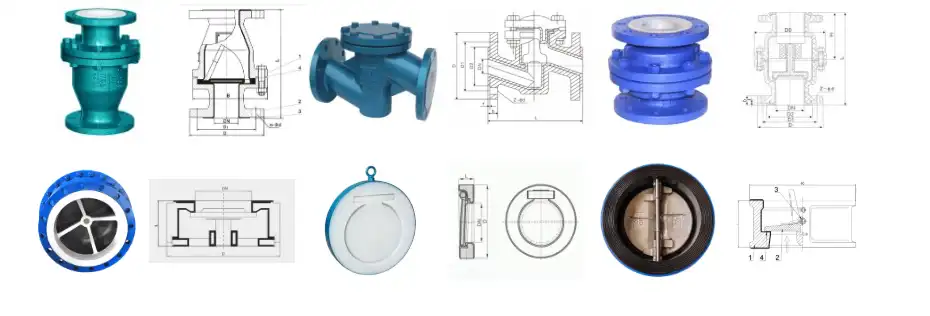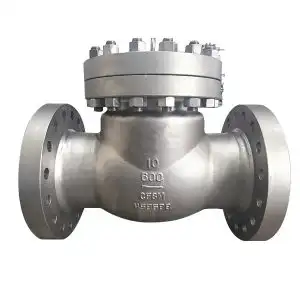Check Valve Mechanism Explained: Essential Installation Tips to Follow

What Is the Working Principle Behind a Check Valve?
Check valves are key parts in fluid systems. They make sure flow goes only one way. They stop reverse flow that could harm devices or upset processes. Knowing how they work is essential for correct choice and setup.
The Function of a Check Valve in Fluid Systems
A check valve is a mechanical part built to let fluid (like liquid or gas) move through it in a single direction. It has a key job in stopping backward flow. Backward flow can break equipment, dirty the medium, or mess up system function. You often find these parts in pipelines, pumps, and many industrial setups. Keeping flow one-way is critical there.
Key Components That Enable One-Way Flow
The main pieces of a check valve usually include the housing, sealing surface, closure element (like a disc or poppet), and sometimes a spring. The closure element is the moving piece that reacts to pressure changes across the part. When forward pressure is greater than backpressure, the closure element lifts off the sealing surface. This allows movement. If backpressure rises above forward pressure, the closure element goes back to its sealing surface. It does this by its own weight or spring power. This blocks reverse movement.
Differences Between Various Types of Check Valves
Check valves come in several kinds. These include swing types, lift types, ball types, and spring-assisted in-line types. Swing types use a hinged closure element. This swings open with forward flow. It shuts under backflow situations. Lift kinds have a vertically moving closure element. This lifts off the sealing surface during forward flow. Spring-assisted designs have an internal spring. This makes sure closing happens fast when movement stops or reverses.
Setup steps can change based on the check valve kind. This difference shows why knowing the specific valve operation is important before putting it in.
Miwival helps reduce wrong use dangers. They offer guidance made for each valve type.
How Does the Internal Mechanism Operate Under Varying Pressures?
Check valve performance depends on pressure changes. These differences occur between the valve’s input and output ports. Knowing its operation well makes sure it works best under different system states.
Flow Direction and Pressure Differential Impact
How a check valve works relies on pressure difference between its input and output. When upstream pressure is more than downstream resistance plus any spring force (in spring-assisted models), it pushes the internal closure element open. On the other hand, when downstream pressure increases or upstream pressure falls below needed levels, the closure element returns to its shut position.
The Role of Spring-Loaded and Swing Mechanisms
Spring-assisted systems give quicker reaction times. This is because of their internal pushing force. They are perfect for uses needing fast shut-off to stop backflow. Swing systems depend more on weight and fluid movement. They are usually better for low-pressure setups with steady directional flow.
Performance Under Backflow Conditions
When backflow happens, how well it works depends on how fast and fully the valve seals. Bad sealing can lead to leaking or pressure shock problems. Spring-assisted kinds often give better sealing results. This is due to their pre-set shutting force.
Proper setup guarantees the best valve results and service time. Miwival tackles this with engineered plans. These keep seal soundness even when pressures change.
Why Is Proper Installation Critical for Check Valve Performance?
Wrong setup can cause valve trouble, leaking, or system problems. Following maker instructions ensures steady operation. It also makes the valve last longer.
Common Issues Arising from Incorrect Installation
Bad setup can lead to reverse leaking, shaking sounds, early damage, or total system breakdown. Frequent errors include wrong way facing relative to flow direction. Putting it in bad pipe layouts is another error.
Orientation and Positioning Guidelines
Proper way facing and location are vital for top check valve results. Wrong setup can cause working failures, less effectiveness, or even system harm. Below are important points for flat and upright setups. Also covered is the importance of flow direction markers. This helps get reliable, lasting function.
Horizontal vs. Vertical Installations
Some check valves are made for flat setups only. Others might support upright use if fluid moves upward. For example, swing-type valves often need flat placement for good operation. They rely on gravity.
Flow Direction Indicators and Their Significance
Most check valves have an arrow sign on their body. This shows the right flow path. Stick to the maker’s directions for correct setup. This ensures best work and system soundness. Ignoring these markers can cause quick failure or long-term weakening.
Importance of Clean Piping and Debris Prevention
Dirt inside piping can block valve motion or cause incomplete sealing. Make sure pipes are clean and dirt-free before setup. This step is key for protecting inside pieces from rubbing or sticking.
Following maker instructions promises a good setup. It protects the system’s soundness and function. Miwival makes this easy with clear signs and papers made for different positions and cleanliness rules.
What Are the Recommended Installation Tips for Long-Term Reliability?
Right choice, alignment, and checking are central to getting top check valve results and life in any fluid system.
Selecting the Right Valve Type for the Application
Every use—like water supply lines, climate control systems, or chemical handling—has special needs. These cover pressure span, heat tolerance, material suitability, and reaction time. Picking the wrong kind risks working problems or safety issues.
Ensuring Correct Pipe Sizing and Alignment
Mismatched pipe sizes create messy flow. This can hurt valve work or speed up damage on sealing faces. Good alignment also lowers strain on joints. It cuts down shaking damage over time.
Pre-Installation Inspection Procedures
Before adding a check valve to your system, complete pre-setup checks are key. This stops early failures or performance troubles. This includes looking for physical harm, checking material suitability, and making sure the piping place is clean and dirt-free. These steps set the base for smooth work and longer valve life.
Checking for Damage or Manufacturing Defects
Before putting any valve piece into your system, look at it for cracks, bending, rust marks, or other faults. These could weaken performance after starting.
Verifying Compatibility with System Materials
Material suitability between valve pieces (like stainless steel housing) and pipe contents (like harsh chemicals) must be checked before final putting together. This stops chemical damage over time.
To start setting up a check valve, check the next steps to ensure correctness: Look over all pieces well before continuing with adding to your pipe system.
Post-Installation Testing and Monitoring
After setup is done, do working tests under safe conditions. This confirms proper opening/shutting action under expected working pressures. Watching over time allows early finding of issues. These include slow closing or leaking.
Miwival improves dependability. They offer strong pre-setup check sheets. They also give after-setup confirmation steps made per field rules.
How Can Maintenance Practices Enhance Operational Efficiency?
Regular upkeep keeps check valves in top shape. This stops surprise failures and costly stops.
Routine Inspection Schedules to Detect Wear or Blockage
Setting regular check times lets you find issues early. These include worn closure elements or build-up near sealing surfaces. Finding them early stops full failures during busy times.
Cleaning Techniques Without System Disassembly
Some new designs allow partial cleaning without full taking apart. This uses flush points or removable covers. It saves both time and work costs. It also keeps cleanliness levels, especially in food-safe systems.
When to Replace Versus Repair a Check Valve
If a look shows unfixable harm like deep marks on sealing faces or bent closure elements that don’t line up right with seats—even after cleaning—replacement is needed. Trying to fix might only help for a short while.
Miwival backs working efficiency with easy-to-use upkeep guides. These help workers tell repairable problems from replacement needs well.
Who Is Miwival and Why Choose Them as Your Check Valve Supplier?

Miwival stands as a trusted maker of high-quality check valves. They offer made solutions for different industrial uses.
Overview of Miwival’s Product Range and Industry Expertise
Miwival focuses on high-performance check valves made for various fields. These include water cleaning plants, oil and gas lines, climate control webs, drug making units, and others. They offer both standard stock models and custom-made answers on request.
Quality Assurance Standards and Compliance Certifications
All Miwival goods go through strict quality checks. These follow ISO 9001:2015 rules. They also have approvals needed in world markets like CE marking where it fits. This ensures safe use in controlled fields everywhere.
Technical Support and Customization Services Offered
From choice help during planning to after-sale tech support—Miwival gives full customer service. Experienced engineers back this up. They are ready to handle tough use problems. These include special material picks or custom coverings on request.
Miwival mixes product variety with approved quality plans. They also give start-to-end tech support. This makes them a great partner for all your check valve buying needs across fields worldwide.
Conclusion
Knowing how check valves work—and sticking to exact setup tips—is key for reliable one-way flow in fluid systems. By picking right kinds based on use details; following way markers exactly; keeping pipes clean; doing full checks; running after-setup tests; setting regular upkeep—and teaming with trusted providers like Miwival—you guard your system against expensive failures. You also get the best long-term results.
FAQs
What is the best orientation to install a check valve?
The best way facing depends on the check valve kind used. Swing types mostly need flat placing. Spring-assisted types may be set upright if fluid moves upward—as long as maker rules are followed right.
Can a check valve be used in both gas and liquid systems?
Yes—but only if building materials suit both media types under expected heat/pressure ranges set by makers like Miwival. They offer dual-use models tested under different states.
How do I know if my check valve is failing?
Signs include odd noises during work (like tapping), visible leaks at joints/seals even when shut—or changing downstream pressure signs showing some backward flow through damaged sealing surfaces.





